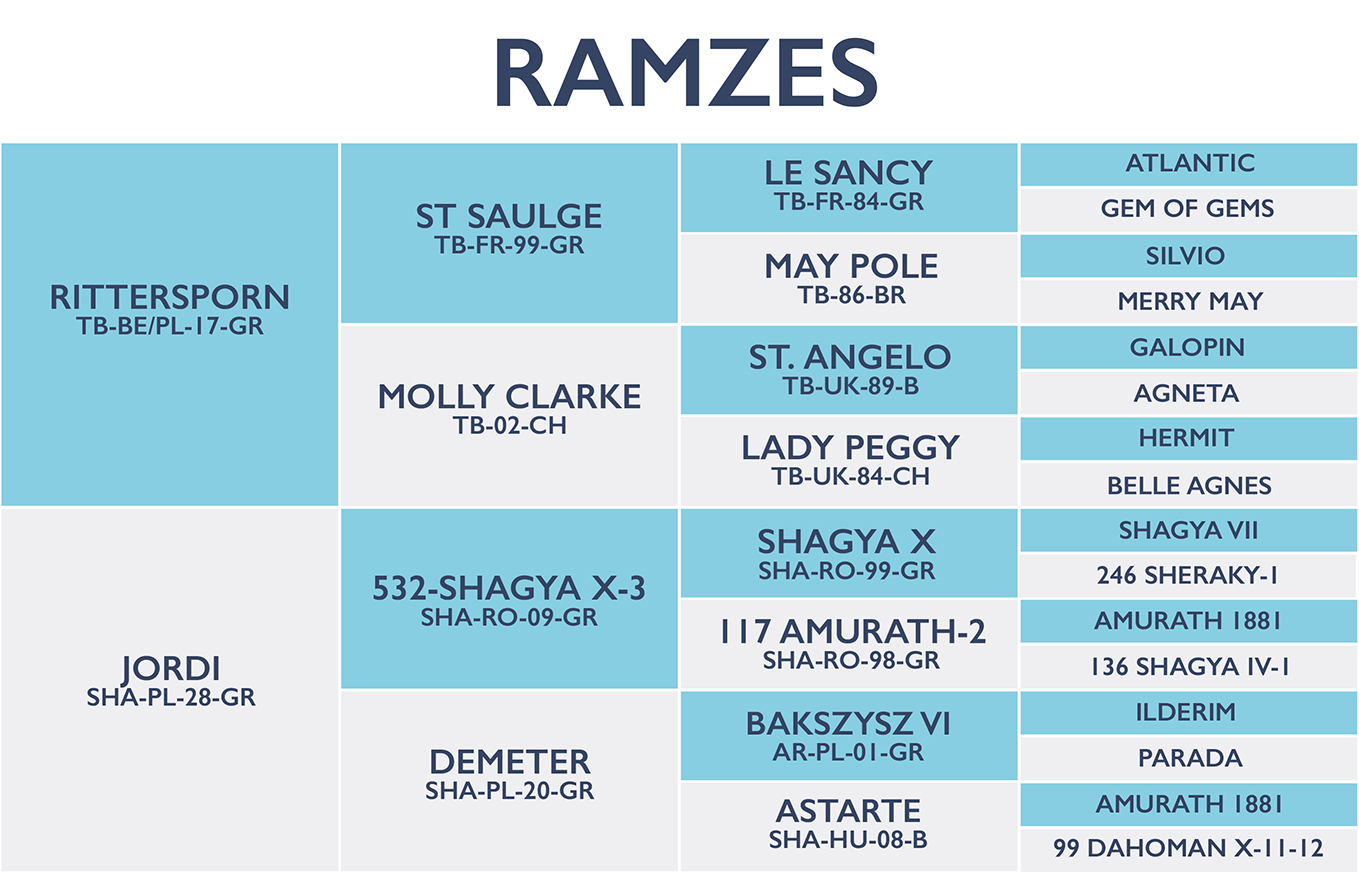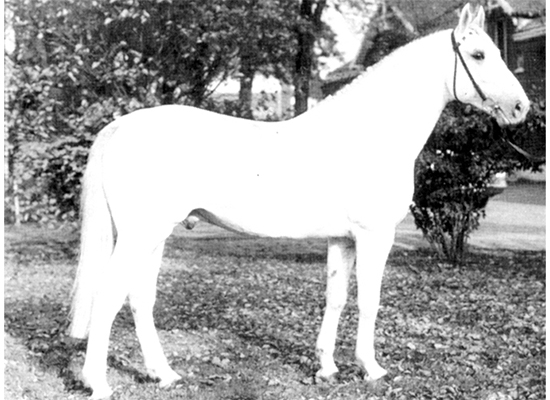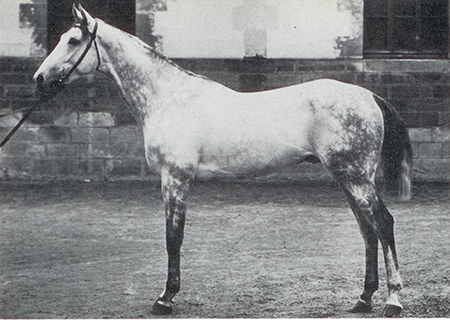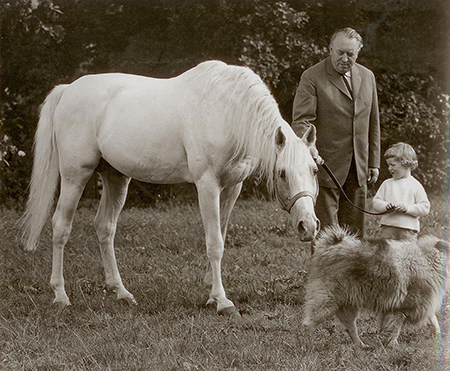1937 162 cm Grey
Breeder: Marie Gräffin Plater-Zyberk
The story of Ramzes goes back 200 years, to a stallion that may be the most influential of all time – Bairactar! (I am indebted for most of the information on this stallion to Jan Tönjes and his article Der Uropa-XXL des Weltsports, in St Georg 4/2014)
King Wilhelm I of Baden-Württemberg became a passionate fan of Arabian horses at the beginning of the 19th century and was looking for an Arabian stallion for his stud in Scharnhausen-Weil. The Baron of Fechtig was sent to Syria and Lebanon where, in 1817, he discovered Bairactar, a descendant of the Siglawy-Jedran line. He soon became King Wilhelm’s favourite riding horse but he was also a prolific breeding stallion, and when he died at the age of 24, he left seven sons and 47 daughters.
The next important stallion was Amurath-Weil, born in 1881. Bairactar can be found 14 times in Amurath’s pedigree. Amurath-Weil was sold to the Radautz Stud, which now belongs to Romania. He produced many stallions that are still significant in the Polish Arabian breeding program, and also in the Shagya Arab breed lines.
It was but a short step, and 40 years, to another grey stallion, Ramzes. Ramzes’ dam, the Shagya Arab mare Jardi goes back to Amurath-Weil and her pedigree includes 28 crosses of Bairactar.
The Shagya is a breed that has been developed over several hundred years from a base of Andalusian, Lipizzan and Polish Warmblood mares, bred to Arab stallions.
The great Thoroughbred stallion, Le Sancy
Ramzes was foaled in 1937 in Poland, he was by the Belgian bred Thoroughbred – and successful racehorse – Rittersporn, who was a grand-son of the great French Thoroughbred jumping sire, Le Sancy. This blood also runs in the veins of Wotan who jumped internationally with Hermann von Nagel in the 1930s and was a member of the German team that won the Rome Nations Cup three times in succession. The Rittersporn daughter, Warzawianka represented Poland at the 1936 Olympics.
During the war, Ramzes was stabled at the Polish Stud, Janow Podlaski, where he was a popular riding and carriage horse. With the Russian forces advancing, the Polish studs that were under German occupation were relocated to Germany, and Ramzes was one of the horses that crossed the border. After 1945, the horses were returned to Poland, apart from a few which the Polish officers rode in the first riding competitions between the Allied forces. These were held from 1946 onward, and Ramzes was the star with Lieutenant M. Bielecki in the saddle. The rider bought him from the Polish government, and after the communist takeover, Bielecki migrated to the United States and offered to sell the grey stallion to Clemens Freiherr von Nagel, who bred sport horses at his property in Vornholz in Westphalia. He knew Ramzes from his time as Director of the Polish Racot Stud during the war.
Baron von Nagel and Ramzes
Baron von Nagel who gave the stallion to German jumping rider, Hans-Heinrich Brinkmann and he competed successfully in elementary and medium jumping classes. However Ramzes broke his front pastern while being exercised. In those days, dealing with broken legs was even more difficult that it is today, and the stallion was hung in the air by a belt attached to the ceiling for weeks. His good temperament saved him for the career as a breeding stallion.
Ramzes was classified by the Westpahlia Breeding Board under breeding value class IV, but he attracted the attention of the Holstein breeding authorities because of his good jumping genes.
He stood at the Holstein in 1951 and 1952 to refine the heavy Warmblood horses of the area. The first foals that were born in Holstein in 1952 were disappointing, they were lightly built, not very big and difficult to sell – many ended in the slaughter house. It was also difficult for his sons to be licensed, their cannon bone circumference of around 20 cm was considered very fine in an era where 24 cm was a more common measurement for stallions.
But his jumping offspring from that first period in Holstein turned the tables. They were stars: Retina, ridden by Fritz Thiedemann, Romanus with Hans Günther Winkler, Ramzes XIII with Kurt Jarasinkski and Ramona with Alwin Schockemöhle, established Ramzes’ fame in Holstein, and resulted in him standing there for two more seasons, in 1959 and 1960.
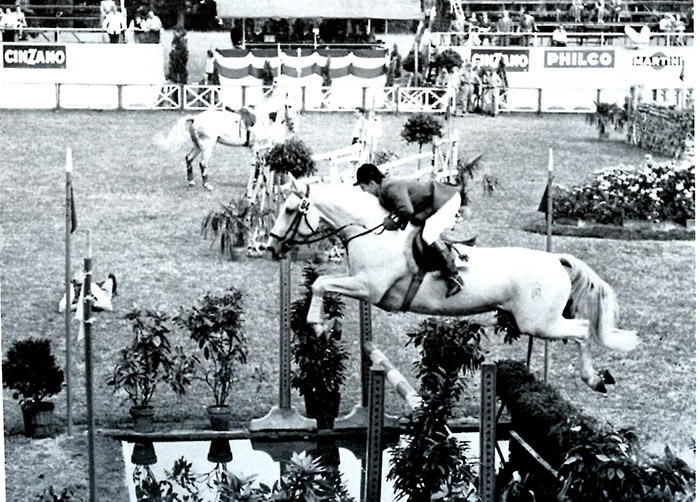
Ramona and Alwin Schockemöhle
Four licensed stallions were bred in the second stud period in Holstein: Roman, Rigoletto, Raimond and Rhenus. Rigoletto was sold to The Netherlands, while Rhenus ended his days in the circus tent. Roman became a good competition horse, and an excellent sire of broodmares. Raimond was a more attractive type than Roman and sired over 120 daughter and eight stallions, but of these, only Ramiro was a success.
While in Holstein, Ramzes bred showjumpers, in Westfalia, he produced dressage horses. The Ramzes son, Remus won individual dressage silver and team gold at the Tokyo Olympics, where he was ridden by Harry Boldt. Two years later, another son, Mariano, ridden by Josef Neckermann, won the World Dressage Championship, with Remus collecting another silver medal. Mariano won silver at the 1968 Games – and four years later, at the Munich Games, another son, Robin was a member of the German gold medal winning showjumping team.
The Ramzes son, Radetzky established in Westfalia a line that led to Romadour II (although there is some doubt about the parentage of Romadour II) and in turn to his gold medal-winning son, Rembrandt.
In his Stallion Book of the Holsteiner Warmblood Breed, Dr Dietrich Rossow has this to say about Ramzes and his influence:
“Ramzes was a medium framed, harmonious stallion with a very well set on neck, which was heavily muscled on the underside. He had a heavy poll, good width and depth of body and clean legs which were very good behind and light boned in front. His head was plain… In general it can be said that his Holsteiner offspring lacked size and were too fine… In conclusion it can be said that Ramzes had a positive effect on the old Holsteiner type. He sired a huge number of beautiful, supple riding horses. He decisively improved on the old, tremendous but high headed, flat backed jumping form. Doubtless because of his gaits, he produced hardly any dressage horses in Holstein. His offspring’s heads are not always the most beautiful.”
In his history of the breed The Holsteiner Horse, Romedio Graf von Thun-Hohenstein, values Ramzes mainly as a carrier of Thoroughbred blood:
“The marvellously positive results were doubtless due to the large percentage of Thoroughbred blood carried by Ramzes himself… Ramzes influence in Holstein seems to have achieved its greatest importance with the whole list of first class approved broodmares which carry his blood. On his dam’s side, Ramzes carried a great deal of Amurath blood, however his offspring did not show any Amurath characteristics. This is probably due to the large percentage of Thoroughbred blood. The hereditary Amurath tendency to produce pacing, which did not necessarily nullify jumping ability as seen in the Argram line of the Hanoverian breed, never occurred in Holstein.”
